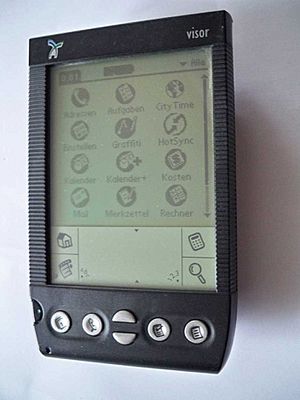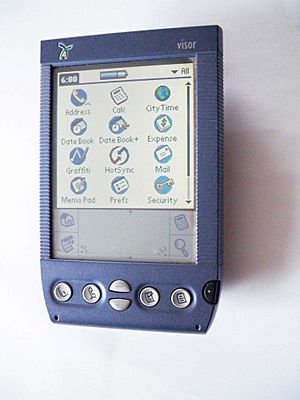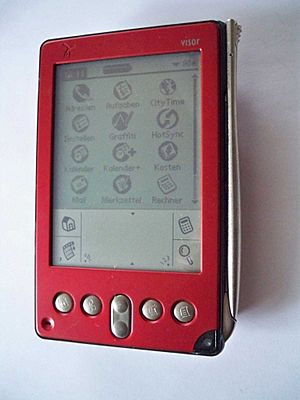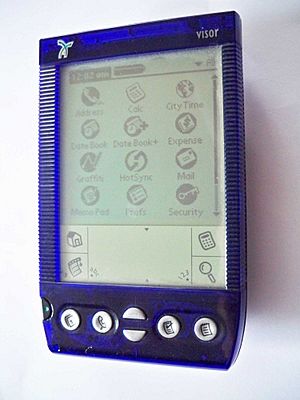Handspring (company) facts for kids
 |
|
| Industry | Personal digital assistants |
|---|---|
| Fate | Acquired by Palm Inc. |
| Founded | June 1998 |
| Founder | Jeff Hawkins Donna Dubinsky Ed Colligan |
| Defunct | 2003 |
| Headquarters | Mountain View, California |
Handspring, Inc. was an American company that made cool electronic gadgets. It was started in 1998 by the same people who created Palm, Inc. They weren't happy with how Palm was being run by its new owner, 3Com.
Handspring made devices called Visors and Treos. These were like early smartphones, known as personal digital assistants (PDAs). They ran on a system called Palm OS. In 2003, Handspring joined forces with Palm, Inc.'s hardware part.
Contents
History of Handspring
Handspring was started in June 1998. Its founders were Jeff Hawkins, Donna Dubinsky, and Ed Colligan. These three people had also created the original PalmPilot and Palm, Inc. They decided to leave Palm after 3Com bought it, because they disagreed with the new plans.
Handspring created a line of PDAs called Visors. These devices could connect to computers using a USB cable. This was much faster than the older ways Palm devices synced. Visors also had a special slot called the Springboard. You could plug in different modules into this slot. These modules could add features like GPS navigation, cameras, music players, or even turn your Visor into a basic cell phone. This made them very much like early "smartphones."
In June 2000, Handspring became a public company. This means its shares could be bought and sold on the stock market. This happened during a time called the dot-com bubble, when many internet and tech companies were very popular. On its first day of trading, Handspring's shares went up by 35%.
In 2003, Handspring joined with Palm, Inc.'s hardware division. This brought the original creators back together with the Palm brand.
Handspring Products
Handspring made two main lines of products: the Visor series and the Treo series.
Visor Series PDAs
The Visor devices were personal digital assistants. They were designed to help you organize your life.
Visor and Visor Deluxe
The first Visor was called the Visor Solo. It was black and had 2MB of memory. The Visor Deluxe came in cool see-through colors. It also had more memory, with 8MB. Both used a special version of Palm OS 3.1H. This system included a better datebook, a world clock, and an advanced calculator.
Unlike older Palm devices, the Visor's infrared port was on the side. This made space for the Springboard Expansion Slot. The Visor and Visor Deluxe weighed about 5.4 ounces. They were about 4.8 inches tall, 3.0 inches wide, and 0.7 inches thick. Their screen was 2.25 inches square.
Visor Prism
When Handspring released the Visor Prism, it was very bright. It was the first Palm OS handheld with a 16-bit color screen. This meant it could show 65,536 colors. At the time, Palm's own color model only showed 256 colors. However, the Prism's screen was hard to see in direct sunlight.
The Prism came in a cobalt-blue case. It used a rechargeable lithium-ion battery, not AAA batteries like other Visors. It still had the Springboard slot and the infrared port on the side. The Prism used Palm OS 3.5.2H3 and weighed 6.9 ounces. Its size and screen were similar to other Visors.
Visor Platinum
The Visor Platinum was much like the Visor Deluxe. It came in silver or black colors. The Platinum had a faster processor, a 33-MHz Motorola DragonBall VZ chip. The Deluxe only had a 16 or 20-MHz chip. The Visor Platinum also used a newer operating system, OS 3.5.2H. When it came out, the Platinum had the fastest processor of any Palm OS device. Like all Visors, it had a microphone. This was meant for cell phone modules that could be plugged into the Springboard slot.
Visor Edge
The Visor Edge was released in March 2001. It was very slim and light. It had a 33 MHz DragonBall CPU. The screen was a standard 160x160 pixel grayscale display. It was the thinnest Visor, at 4.7" x 3.1" x 0.44" and weighing 4.8 ounces. It had 8MB of memory and used Palm OS 3.5.2H.
The Edge came in Metallic Blue, Silver, and Red. It had a built-in rechargeable battery that lasted two to four weeks. Because it was so thin, the Springboard slot was not built-in. Instead, you used a slide-on sleeve to attach Springboard modules.
Visor Neo
The Visor Neo was released in September 2001. It had a 33 MHz DragonBall processor and 8MB of memory. It also had an infrared port and the Springboard slot. The Neo had a 160x160 pixel grayscale screen. It weighed 5.4 ounces and came in translucent Blue, Red, or Smoke-grey. It used Palm OS 3.5.2H3.
The Neo ran on two AAA batteries, which could last up to two months. This model was sold at a lower price. Handspring hoped it would attract new users. All Visor screens were 2.25 inches square.
Visor Pro
The Visor Pro was released in September 2001. It was Handspring's last model in the Visor series. It had a 33 MHz DragonBall processor and weighed 5.7 ounces. The Pro came with 16 MB of memory. It also had a built-in microphone and the Springboard slot. It had a grayscale, backlit screen. Its power came from a rechargeable lithium-ion battery.
Comparing Visor Models
| Name | Solo | Deluxe | Prism | Platinum | Edge | Neo | Pro |
|---|---|---|---|---|---|---|---|
| Memory Size | 2MB | 8MB | 8MB | 8MB | 8MB | 8MB | 16MB |
| Processor Speed | 16 MHz | 20 MHz | 33 MHz | ||||
| Palm OS Version | 3.1H | 3.1H/3.1H2 | 3.5.2H3 | 3.5.2H | 3.5.2H | 3.5.2H3 | 3.5.2H3 |
| Colors Available | Black | Black, Blue, Green, Orange, Clear | Cobalt Blue | Black, Silver | Red, Blue, Silver | Red, Blue, Gray | Silver |
| Display Type | Grayscale | Grayscale | Color | Grayscale | Grayscale | Grayscale | Grayscale |
| Battery Type | 2xAAA | 2xAAA | Rechargeable | 2xAAA | Rechargeable | 2xAAA | Rechargeable |
| Release Date | September 1999 | October 2000 | March 2001 | September 2001 | September 2001 | ||
Handspring Treo Smartphones
In early 2002, Handspring stopped making Visor devices. They started making a new line of devices called Treo. These were more focused on communication. Except for one model, all Treo devices were smartphones. This means they had a cell phone built right in. Most Treos also had built-in keyboards. This made it easier to send e-mails and text messages (SMS).
The Treo line was very successful. This was partly because of Handspring's special VisorPhone software. It worked very well with the Palm OS. The Springboard feature was no longer on the Treo line. Handspring wanted to make thinner designs. There wasn't enough room for the large Springboard slots. Newer technologies like SDIO cards also made the Springboard less needed. Also, many features that Springboard modules offered, like extra memory or a camera, could now be built into the phone itself.
Treo 180 / 180g
The first Treo models were the Treo 180 and 180g. They came out in February 2002. They were black and white GSM phones. The 180 had a small keyboard built-in. The 180g had a special area for writing with a stylus instead of a keyboard.
Treo 90
Handspring released the Treo 90 in April 2002. The Treo 90 was the only Treo that was not a smartphone. It could not make phone calls. When it was released, it was the smallest Palm OS device. The Treo 90 was the first to have a color screen and an SD card slot. These features were then used in all later Treo models.
Treo 270 / Treo 300
The Treo 270 and Treo 300 were very similar models. The 270 worked on GSM networks. The 300 was a CDMA phone, released by Sprint Corporation.
Treo 600
The Treo 600 was the first Treo to be sold as a Palm, Inc. product. This happened after Palm bought Handspring. It was called the PalmOne Treo 600. The GSM version of this phone was one of the few phones that worked on four different frequency bands in the United States at the time.







